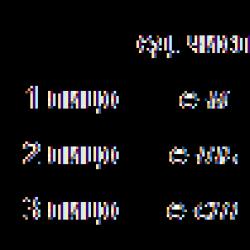Payroll postings. Directory “Methods of reflecting wages in regulated accounting Reflecting wages in regulated accounting
In the 1C:UPP program, the documents “Payroll” and “Salary payment” do not provide any accounting and tax entries. For the purpose of reflecting wages in regulated accounting in 1C:UPP, a special document “Reflection of wages in regulated accounting” is used. The directory "Cost Items" in 1C:UPP is analytics for cost accounts in accounting and tax accounting. Let's add two new elements to the "Cost Items" directory (Figure 1).
Figure 1. Cost items
We created the article “Salaries (General Expenses)” to record the salaries of management personnel.
We created the article “Salaries (Production Expenses)” to record the salaries of production personnel.
To create various ways of reflecting the “basic” salary of employees and individual planned and one-time accruals and deductions in accounting and tax accounting, use the reference book “Methods of reflecting salaries in accounting.”
Each element of the directory represents the correspondence of accounts with the specified analytical elements, if the accounts require it.
There are several predefined elements in this reference.
If necessary, the directory is supplemented by the user independently.
Tax entries are not included in this directory. They are generated automatically.
Let's create template entries in the reference book "Methods of reflecting wages in accounting" to reflect wages in regulated accounting in 1C:UPP (Figure 2).

Figure 2. Methods of reflecting wages in regulated accounting.
Using the "General business expenses account 26" reflection method, entries will be created to reflect the salaries of the management personnel of the enterprise. As an expense item, we note the item “Salaries (General Household Expenses)”.
Using the "Main production 20 account" reflection method in 1C:UPP, postings will be created to reflect the salaries of the enterprise's production personnel. As an expense item, we note the item “Salaries (Production Expenses)”.
Setting up accounting entries for accruals
Reflection of salaries in regulated accounting- these are wiring.
Postings for accruals can be entered in several ways. Let's look at the possibilities for entering transactions and then arrange them in order of priority.
Accounting for the basic earnings of employees of organizations
It is possible to specify the rules for reflecting the earnings of an organization's employees in the form of the "Organizations" directory. In this case, the information register “Accounting for the organization’s main earnings” is used.
Let's open the "Organizations" directory and select the organization of the Southern Federal District MebelStroyKomplekt plant (Figure 3).

Figure 3. Reflection of employee earnings in the form of the "Organizations" directory.
On the “Salary Accounting” tab, clicking “Set salary accounting for an organization” will open the “Salary Accounting for Organization Employees” register. In order for the entire salary of the employees of the Southern Federal District organization MebelStroyKomplekt Plant to be taken into account according to the method of reflection “General expenses account 26”, we will add the following entry to the register (Figure 4).

Figure 4. General expenses account 26.
Accounting for the basic earnings of employees of organizational units
Let's open the directory "Divisions" and select the division Administration of the Southern Federal District of the organization Southern Federal District MebelStroyKomplekt plant (Figure 5).

Figure 5. 1C:UPP. Division directory.
On the Payroll Accounting tab, clicking “Set payroll accounting for division employees” will open the “Salary accounting for division employees” register. In order for the entire salary of employees of the Administration of the Southern Federal District to be taken into account using the “General business expenses account 26” method of reflection, we will add the following entry to the register (Figure 6).

Figure 6. Salary accounting tab.
In order for the entire salary of the employees of the Workshop of the Southern Federal District to be taken into account according to the method of reflection “Main production 20 account”, we will open the division of the Workshop of the Southern Federal District in the directory and add the following entry to the register (Figure 7).

Figure 7. Accounting for basic earnings.
Document Accounting for the basic earnings of the organization's employees in regulated accounting
To register changes in the reflection of the salaries of the organization's employees in regulated accounting, use the document "Accounting for the basic earnings of the organization's employees in regulated accounting" (Interface Calculation of salaries of organizations/menu Salary accounting/Entering information about accounting for employees' earnings). The document can be entered on the basis of hiring or personnel transfer.
When the document is posted, it makes an entry in the information register “Accounting for basic earnings in the regulatory accounting for employees of organizations.” For employee Bashirova, we will select from the reference book “Methods of reflecting wages in accounting” the reflection method “Test 25 account” (Figure 8).

Figure 8. Accounting for basic earnings in regulated accounting.
Document Entering the distribution of the basic earnings of the organization's employees
The document allows you to register the distribution in accounting of the basic earnings of employees according to several methods of reflection in a given proportion for the month specified in the document. You can find the document: interface Calculation of salaries of organizations / menu Salary accounting / Entering information about the distribution of basic earnings of employees.
Using the document, we will appoint I.V. Bashirova. distribution of earnings: 20% according to the “General business expenses 26 account” method, 80% according to the “Main production 20 account” method (Figure 9).

Figure 9. Distribution of basic earnings.
Document Entering information on regulated accounting of planned accruals for employees of organizations
To register changes in the reflection of permanent accruals of employees of organizations in regulated accounting, with the exception of basic earnings (accounting rules for which are registered in the document "Accounting for the basic earnings of employees of organizations in regulated accounting"), the document "Input of information on the regulated accounting of planned accruals of employees of organizations" (interface Calculation of salaries of organizations/menu Salary accounting/Entering information about accounting for planned accruals). When the document is posted, it makes an entry in the information register “Regulation of planned accruals to employees of organizations.”
Using the document, we will assign I.V. Bashirova: accounting for salary using the method “General expenses 26”, accounting for the regional coefficient using the method “Main production 20” (Figure 10).

Figure 10. Entering information about regulated accounting of planned accruals.
Setting up the distribution of accruals and deductions across accounting accounts can be done in the plans of the calculation types "Basic accruals of the organization", "Additional accruals of the organization".
Let's open the Plan of calculation types "Basic accruals of the organization", select the accrual type Salary by day. On the “Accounting and UTII” tab, select the method of reflecting “General business expenses 26 accounts.” (Figure 11).

Figure 11. Setting up calculation types.
Priority when entering transactions for accruals
When filling out a document, postings are determined in accordance with the methods by which they were assigned. In this case, the following priority condition for accruals is observed depending on the method in which the posting is assigned (in descending order):
1) postings generated by the documents: “Contracts for the performance of work with individuals”, "Accrual on sick leave for organizations", "Piece earnings", "Loan agreement"
2) entries entered by the document “Inputting information on accounting for planned accruals to employees of organizations”
3) transactions entered through setting up payment types
4) entries entered by the document “Entering information on accounting for the basic earnings of employees of organizations”
5) directory "Divisions", information register "Accounting for salaries of department employees"
6) directory "Organizations", information register "Accounting for the main earnings of an organization"
7) reference book "Methods of reflecting wages in accounting" - reflection of accruals by default.
Document Reflection of salaries in regulated accounting
For the automated generation of entries for accounting and tax accounting of accrued wages, the document “Reflection of wages in regulated accounting” is intended. When you click on the “Fill” button, the data from the previously performed salary calculation will be reflected in the document in the following section:
· On the “Basic accruals” tab, the expected reflection in accounting and tax accounting of basic accruals to employees (for each employee and type of accrual) will be shown, based on the rules available in the information base for reflecting accruals in regulated accounting;
· On the “Additional accruals” tab - the same regarding additional accruals;
· On the “Transactions” tab, summary transactions for reflecting wages in accounting and tax accounting will be shown.
Thank you!
In order to ensure the unity of the wage accounting methodology, the enterprise maintains analytical and synthetic accounting of settlements with personnel for wages. Analytical accounting data must correspond to the turnover in synthetic accounting accounts.
Synthetic accounting of wages and salary calculations is carried out on passive balance sheet account 70 “Payroll calculations”.
The Credit of the account reflects the amount of accruals for all types of basic and additional wages, bonuses, temporary disability benefits, pensions for working pensioners, income from securities and other payments.
The debit of the account reflects the amounts paid for wages, bonuses, benefits, as well as deductions from accrued amounts and amounts accrued but not paid on time.
The credit balance shows the amount of accrued but not paid wages.
The amounts of accrued basic and additional wages are distributed according to cost areas, i.e. written off from the credit of the balance sheet account 70 “Calculations for wages” to the debit of the corresponding balance sheet accounts: 20 “Main production” - the basic wages of workers directly involved in the production process, 23 “Auxiliary production”, 25 “General production expenses”, 26 “General expenses" - 29 "Service of production and economy" - wages of workers not engaged in the main production, etc.
At the same time, their amounts are recorded in the production cost accounting sheet for orders, items, workshops, and on their basis - in journals - orders No. 10 and 10/1. They also reflect the amount of accrued wages to workers during vacation.
Analytical accounting of wage calculations is carried out in the following forms of accounting documentation: timesheets and wage calculations, payroll, payroll, payroll, personal account, book of settlements with depositors, register of deposited wages, piece work order work.
Analytical accounting of calculations for labor remuneration and payroll is carried out in the following main areas:
- - for each employee, regardless of the time of his work at the enterprise;
- - by type of accrual;
- - by sources of payments;
- - by structural divisions;
- - by type of products manufactured, services provided, work performed.
At the work station of the accountant, the main direction of analytical accounting is the organization of accrual accounting for each specific employee.
accounting wages wage audit
Typical accounting entries for accounting for accruals and deductions from wages:
|
Salaries are calculated based on tariffs and official salaries:
|
|
|
|
Overpaid amounts of wages were deposited into the cash register |
||
|
Temporary disability benefits and other accruals were accrued from extra-budgetary funds |
||
|
Amounts due to employees at the expense of other enterprises, third parties, etc. have been accrued. |
||
|
Calculation of employee benefits at the expense of profits |
||
|
Restoration of amounts of shortfalls previously attributed to employees |
||
|
When creating reserves in the prescribed manner, the following are accrued:
|
||
|
Wages paid to employees from the cash register |
||
|
Personal income tax withheld |
||
|
Deductions were made from the employee’s salary to repay the loan amount |
||
|
Deductions under writs of execution in favor of third parties |
||
|
Salary not received on time was deposited |
||
|
The debt for the advance payment issued on account was withheld from the employee’s salary |
||
|
Amounts were withheld from the salaries of the guilty persons to cover shortfalls in excess of the norms of attrition and losses from damage |
Payroll calculations involve determining the total amount accrued to each employee.
The calculation of direct wages for time workers and salary workers is carried out in the Time Sheet and calculation of wages.
Piece workers are paid according to time sheets and in work orders or other documents of the same type. After completing the task, the foreman closes the work order and enters into it the number of accepted products or work performed, indicates the time worked, the total amount of remuneration and the percentage of additional payment, cost accounting codes to which the accrued wages relate, as well as the presence of defects.
Where appropriate, they usually use enlarged, complex norms and prices, as well as multi-day (cumulative) primary documents (for a week, ten days, two weeks, a month, for a cycle of operations or work) instead of one-time and one-day orders. Regardless of the adopted remuneration system, in order to determine the amount of wages to be paid to employees, it is necessary to determine the amount of earnings for the month, reflect all accruals and make all deductions. These calculations are usually made in the payroll sheet (in which the data is generated from the timesheet and accumulative sheet). In some organizations, instead of a payroll sheet, they use separate payroll and payroll sheets.
At the end of the payroll, after the last entry, a final line is drawn for the total amount of the payroll. An expense cash order is drawn up for the amount of wages paid, the number and date of which are indicated on the last page of the statement.
One line is allocated for each employee in the statement. Statements are used for settlements with employees for the whole month.
Thus, the earnings due are shown in these statements by structural divisions and services of the organization and types of payments, i.e. in the context that is necessary to control the use of the wage fund and draw up various certificates and reports.
In practice, various deviations in technological and production processes arise that require additional payment. Such deviations and additional payments include: working overtime, working on weekends and non-working holidays, night work, combining professions, failure to comply with labor standards (job duties) not through the fault of the employee, downtime due to the fault of the employer, defective products not due to the fault of the employee, hard work, work with harmful and (or) dangerous and other special working conditions.
Additional payments must be documented in the following documents: a) additional operations not provided for by the production technology - a piecework work order, which usually contains some kind of distinctive sign (for example, a bright diagonal line); b) deviations from normal working conditions - a slip for additional payment, which is issued to the team or individual worker. It indicates the number of the main document (work order, statement, etc.) for which the additional payment is made, the content of the additional operation, the reason and culprit for the additional payment and the price.
Article 136 of the Labor Code of the Russian Federation establishes that wages are paid at least every half month on the day established by the internal labor regulations, collective agreement, and employment contract.
If the payment day coincides with a weekend or non-working holiday, wages are paid on the eve of this day.
Payment for vacation is made no later than three days before it starts.
The amount of the advance is determined in the document according to the accounting policy of the enterprise. As a rule, it is 30-40% of earnings.
The following entries are made in the accounting accounts for the amount of advances issued:
D-t 70 “Settlements with personnel for wages” K-t 50 “Cash desk”
There are strict deadlines for paying wages from the cash desk - three days from the date of receipt of cash at the bank institution. On these days, it is allowed to keep cash in the cash register in excess of the established limit.
Amounts accrued but not paid on time are reflected as follows:
Dt 70 “Settlements with personnel for wages”
K-t 76/4 “Settlements with various debtors and creditors” sub-account “Settlements for deposited amounts”.
If wages are not received on time, then in the payroll opposite F.I.0. employee with a special stamp or by hand makes a note “deposited”, and the amounts not issued are called deposited and are handed over to the bank.
On the front side of the payroll, the cashier makes a note about its closure. In this case, the amounts of cash paid and deposited wages are indicated. A register of unpaid wages is compiled for deposited amounts. The closed payroll and the register of unpaid wages are transferred by the cashier to the accounting department, to the settlement department. After checking them, the accountant issues a cash receipt for the amount of the paid wages, prepares it and transfers it to the cash desk for drawing up a cashier’s report.
In the accounting department of an enterprise, accounting of deposited amounts is kept in the Book of Accounting of Deposited Amounts. The book opens for a year. Accounting is maintained by production divisions (shops, departments). The amount of debt for unpaid wages is recorded for three years. After this period, it is included in the enterprise’s income as non-operating income. Payment of deposited amounts is formalized by an expense order or payroll.
Payroll entries in a budgetary institution are an important part of accounting. In this article we will try to understand the correct accounting of wage costs in budget organizations.
Regulatory framework
Postings on wages in a budgetary institution are regulated by several legislative acts, in particular:
- A unified chart of accounts for government agencies, local governments, management bodies of state extra-budgetary funds, state academies of sciences, state (municipal) institutions (Order of the Ministry of Finance of the Russian Federation dated December 1, 2010 No. 157n);
- Instructions for the use of the chart of accounts for budget accounting (Order of the Ministry of Finance dated December 16, 2010 No. 174n).
What to include in employee salaries according to current legislation, read the material "St. 135 Labor Code of the Russian Federation - questions and answers" .
The procedure for generating salary transactions in a budget organization
In the budgetary sphere, to detail the flow of funds, a classification of operations of the general government sector (abbreviated as KOSGU) has been developed. In this case, when generating transactions, a code should be added to the accounting account that determines the type of receipt or disposal of an accounting object in accordance with this classification.
In particular, to calculate salaries, an accountant needs to use the following KOSGU codes:
- 211 - “Salaries”: here it is necessary to include expenses for all payments of funds in accordance with contractual obligations; in addition, it reflects various deductions from the employee’s accrued salary (union membership dues, personal income tax, compensation for moral damage caused by the employee, alimony, etc.);
- 212 - “Other payments”: used to accrue expenses for payment of additional payments and compensations not related to wages (for example, daily allowances for business trips, compensation for the use of a car, etc.);
- benefits, for example, those paid at the expense of the Social Insurance Fund to employees, are classified under subsection 213 (including maternity benefits, one-time benefits for the birth of a child, monthly child care benefits, etc.).
Also, for the correct distribution of cash flow types, we will need the following KOSGU:
- 730 - “Increase in other accounts payable”;
- 830 - “Reduction of other accounts payable”;
- 610 - “Disposal from budget accounts.”
Read about how the budget accounting account number is linked to the value of KOSGU.
Postings on salaries in a budgetary institution
Based on the above regulatory documents, we will draw up the main entries for wages in the accounting of a budgetary organization.
1. Salary, vacation pay, bonus have been accrued.
In this case, wage costs can be attributed to several different accounting accounts:
- Dt 0 401 20 211 “Salary expenses” Kt 0 302 11 730 “Increase in payables for wages”
- Dt 0 109 61 211 “Wage costs in the cost of finished products” Kt 0 302 11 730
- Dt 0 109 71 211 “Overhead costs of production of finished products, work, services for wages” Kt 0 302 11 730
- Dt 0 109 81 211 “General business expenses for the production of finished products, work, wage services” Kt 0 302 11 730
2. Personal income tax accrued:
Dt 0 30211 830 “Reducing payables for wages” Kt 0 30301 730 “Increasing payables for personal income tax”
3. The accrual according to the writ of execution is reflected:
Dt 0 30211 830 Kt 0 304 03 730 “Increase in accounts payable for settlements of deductions from wage payments”
4. Salaries paid from the cash register:
Dt 0 30211 830 Kt 0 20134 610 “Cash funds of a budgetary institution”
5. Salaries are transferred to bank cards:
Dt 0 302 11 830 Kt 0 20111 610 “Disposal of the institution’s funds from personal accounts with the treasury authority”
6. Unpaid amounts deposited:
Dt 0 30211 830 Kt 0 30402 730 “Increase in accounts payable to depositors”
7. Contributions to the Pension Fund, Social Insurance Fund, and Federal Compulsory Medical Insurance Fund have been accrued.
Every month, each organization pays insurance contributions to the Pension Fund, mandatory social contributions to the Social Insurance Fund and the Federal Compulsory Medical Insurance Fund. The object of taxation is payments and other remuneration accrued by employers in favor of employees.
Postings for accrual of contributions are generated as follows. The debit account will be permanent - Dt 0 40120 213 “Expenses for accruals for wage payments.” But the corresponding account will depend on the type of accrual:
- Kt 0 303 10 730 “Increase in accounts payable for insurance premiums for compulsory health insurance”;
- Kt 0 303 02 730 “Increase in accounts payable for contributions to compulsory social insurance”;
- Kt 0 303 06 730 “Increase in accounts payable for insurance against accidents and occupational diseases”;
- Kt 0 303 07 730 “Increase in accounts payable for compulsory medical insurance.”
8. The salary was issued to the accountable person distributing the salary from the cash register:
Dt 0 20811 560 “Settlements with accountable persons for salaries” Kt 0 20134 610 “Cash in the institution’s cash desk.”
9. An employee received a salary from the distributing person:
Dt 0 30211 830 “Reduction of payables for wages” Kt 0 20811 660 “Settlements with accountable persons for wages.”
An example of how payroll is reflected in the accounting of a budget organization
Let's look at the entries for payroll in the accounting of an enterprise using a specific example.
Example
The official salary of a hospital employee is 24,000 rubles. The employee does not have children, therefore, he is not entitled to the standard deduction.
Accrued income for March 2018 is RUB 24,000.
Postings for recording transactions related to the accrual and payment of wages will be as follows:
|
Debit |
Credit |
Amount, rub. |
|
|
Employee's wages accrued |
0 401 20 211 |
0 302 11 730 |
|
|
Personal income tax accrued |
0 302 11 830 |
0 303 01 730 |
3,120 (24,000 × 13%) |
|
Salaries issued from the cash register |
0 302 11 830 |
0 201 34 610 |
20 880 (24 000 - 3120) |
|
Insurance premiums charged to the Pension Fund - 22% |
0 401 20 213 |
0 303 10 730 |
5,280 (24,000 × 22%) |
|
Insurance premiums charged to the Social Insurance Fund - 2.9% |
0 401 20 213 |
0 303 02 730 |
696 (24,000 × 2.9%) |
|
Accident insurance premiums charged - 0.2% |
0 401 20 213 |
0 303 06 730 |
48 (24,000 × 0.2%) |
|
Insurance premiums charged to the Federal Compulsory Compulsory Medical Insurance Fund - 5.1% |
0 401 20 213 |
0 303 07 730 |
1,224 (24,000 × 5.1%) |
Results
The use of current instructions for budgetary institutions and KOSGU codes is important for the formation of wage postings. Correct reflection of wages in accounting accounts will allow the movement of government funds to be distributed among expense items without errors.
The application solution provides a number of settings for reflecting regulated salaries and related taxes and contributions in regulated (accounting and tax) accounting.
Setting up the reflection of salaries in regulated (accounting and tax) accounting can be done both for individual accruals and for the basic earnings of employees. When reflecting wages in accounting, the basic earnings of employees are understood as accruals that correspond to the organization’s wage system, for example, payment based on salaries, tariffs, piecework earnings, etc.
Accounting methods can be specified:
- For planned accruals for specific employees. Registration of the reflection method is carried out by a document Entering information about regulated accounting of planned accruals.
- For basic and additional charges. Fill in the details Reflection in accounting forms of the type of main and additional accrual.
- For basic employee accruals. Registration of the reflection method is carried out in a document.
- For basic accruals of department employees. Fill in the details Method of reflection in accounting in the form of a directory element Organizational divisions.
When reflected in accounting, the methods of reflection are used in the following sequence:
- if a method is specified for recording a specific planned accrual for a specific employee, this method is used;
- if a method for recording a specific accrual is specified, this method is used;
- if the distribution of basic earnings is registered according to several methods of reflection for the current month, these methods of reflection are used;
- if the earnings of a specific employee are reflected in the accounting records, this method is used;
- if the division's earnings are reflected in the accounting records, this method is used;
- if nothing was specified for accrual, the method is used Reflection of accruals by default.
As a rule, organizations use two main options for setting up the reflection of employees’ basic earnings in accounting:
- Settings for each employee. Registered by document Accounting for the basic earnings of the organization’s employees in regulated accounting.
- Settings for all department employees. Registered in the form Organizational divisions on the bookmark Reflection in accounting.
Document Entering the distribution of the basic earnings of employees of organizations you can change the reflection in the accounting of the basic earnings of employees for the month specified in the field Month.
The document can be used to register the method of recording a specific accrual for a specific employee in accounting. With this document it makes sense to register planned accruals, which for a given employee must be reflected in accounting differently from the main accruals.

Please note that registration of this reflection method has maximum priority. You can cancel the registration of reflection in the accounting of a specific accrual for an employee only by registering the reflection in the accounting of this accrual with an empty method of document reflection Entering information about routine accounting of planned employee accruals.
Specifying a specific method of recording in the accrual itself makes sense for accruals that need to be reflected in accounting equally for all employees, regardless of the specified method of reflecting basic earnings.
To reflect payments or deductions accrued to employees in the “1C: Accounting 8 (rev. 2.0)” program, you must fill out the directories “Methods of reflecting salaries in accounting”, “Accruals of organizations” (types of calculation) and indicate the correct information in them.
Let's look at a few examples.
Reflection of salaries of production workers
Example: The enterprise has production, and the wages of production workers should be credited to account 20, with appropriate analytics.Actions in the program:
1. Information about accounting entries for accrued payments is contained in the reference book “Methods of reflecting wages in accounting” (menu “Salary - Information about accruals” or the “Salary” tab). By default, it has two values: “do not reflect in accounting” and “Reflect accruals by default” (account 26). To reflect wages on account 20, we will create a new reflection method, indicate the debit account: 20, and the analytics for this account. Credit account: 70. The “Type of accruals” requisite is used to include accruals in labor costs in accordance with Article 255 of the Tax Code of the Russian Federation.
2. Information on accruals assigned to employees is contained in the directory “Basic accruals” (“Accruals of organizations”, also called “types of calculation”). The directory is available through the “Salary - Information on accruals” menu or the “Salary” tab. By default, there is one accrual “Salary by day”. Let's create a new accrual; you can use copying. We indicate the created method of reflecting accruals to account 20. Next, it is important to correctly fill out the following details: type of personal income tax: 2000 (Remuneration for performing labor or other duties...), type of income for insurance premiums: Income entirely subject to insurance premiums.

3. In the “Hiring” (or “Personnel Transfer”) document, in the “Type of calculation” field for production workers, we will indicate the new accrual:

4. At the end of the month, we create the document “Calculation of salaries to employees.” When filling automatically, the types of calculations specified for employees are substituted:

5. We carry out the document “Calculation of salaries to employees.” Postings have been generated in Dt account 20, in accordance with the settings (the figure does not show data for all employees):

6. We create and implement the regulatory document “Calculation of taxes (contributions) from the payroll.” Contributions to the salaries of production workers will also be charged to account 20.
Reflection of the fine accrued to the employee
Example: The employee was assessed a fine, the amount was posted to account 73 “Calculations for compensation for material damage.”Actions in the program. Of course, you can reflect the fine by manual operation. But if such an accrual has to be done repeatedly, then it makes sense to enter information into the program to reflect it.
1. Create a new way to reflect wages “Fine”. Since this is a deduction, it will be posted to the debit of account 70 and the credit of 73.02. We do not indicate the type of accrual.

2. Create a new type of calculation (accrual) “Fine”. We do not fill in the type of income under personal income tax and the type of accrual under the tax code. However, the type of income for insurance premiums is required to be filled in, so we select “Income that is not subject to insurance premiums.” Specify the created reflection method:

3. At the end of the month, we create the document “Calculation of salaries to employees.” We manually add a line, indicating the employee, the type of calculation “Fine” and the amount:

4. We carry out the document “Calculation of salaries to employees.” The fine is reflected by posting Dt 70 Kt 73.02, in accordance with the settings:
Example: The employee was on sick leave and received temporary disability benefits. The first two days of illness are paid at the expense of the employer, the costs are charged to account 26. The subsequent days of illness are paid at the expense of the Social Insurance Fund.
Actions in the program:
1. To reflect benefits from the Social Insurance Fund, we are creating a new way to reflect salaries. Debit account: 69.01 “Calculations for social insurance”, analytics: “Insurance expenses”. Loan account: 70, type of accrual is not filled in.

2. We create a new type of calculation (accrual) for benefits from the Social Insurance Fund. Specify the created reflection method. Type of income for personal income tax: 2300 (Temporary disability benefits), insurance contributions: “State compulsory social insurance benefits paid at the expense of the Social Insurance Fund.” We do not indicate the type of accrual under Article 255 of the Tax Code of the Russian Federation, since benefits are not included in wage costs.

3. A benefit for a bank account at the expense of the employer can be reflected in accounting using the “Default” method of reflecting expenses (account 26). But in order for payments to be correctly taken into account when calculating personal income tax and insurance premiums, it is necessary to create an accrual (type of calculation) and indicate the appropriate types of income. We create an accrual, indicate “Reflection of accruals by default”, type of income for personal income tax: 2300 (Temporary disability benefits). The benefit is not subject to insurance contributions, so we select “Income wholly not subject to insurance contributions, except for benefits at the expense of the Social Insurance Fund...”. We do not indicate the type of accrual under Article 255 of the Tax Code of the Russian Federation, since benefits are not included in wage costs.

4. The 1C: Accounting program is not intended for calculation wages and other payments. Therefore, we calculate benefit amounts outside the program. At the end of the month, we create the document “Calculation of salaries to employees” in the program. We manually add lines in which we indicate the employee, the types of payment for payments at the expense of the employer and at the expense of the Social Insurance Fund, and the amount of benefits. We also change the amount of accrued salary for this employee, since salary is not paid during illness.

We carry out the document “Calculation of salaries to employees.” The amounts of salary and wages at the expense of the employer are included in the account. 26, the amount b/l at the expense of the Social Insurance Fund - to the account. 69.01с subconto “Insurance expenses”, according to the settings:

In order for the payment of benefits at the expense of the Social Insurance Fund to be reflected in the accounting of insurance premiums, it is necessary to create and carry out a regulatory document “Calculation of taxes (contributions) from the payroll fund.” It generates not only accounting entries, but also movements in the tax and contribution registers, in particular, in the “Income Accounting for the Calculation of Insurance Premiums” register:

We will generate a report “Insurance Contribution Card” (menu “Salary - Accounting for personal income tax and taxes (contributions) from payroll” or the “Salary” tab). The card, in addition to the base for calculating contributions and the contributions themselves, reflects the non-taxable amount of benefits at the expense of the employer, as well as the amount of accrued benefits at the expense of the Social Insurance Fund.







